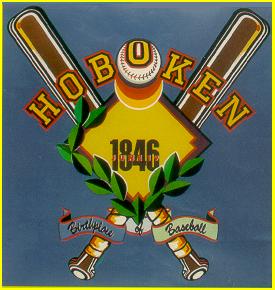 |
 Hoboken and the Beginnings of Baseball
Hoboken and the Beginnings of Baseball
By Nicholas Acocella
Part 3a - The Cartwright Rules (1)
Cartwright did not invent Base Ball out of whole cloth; on the contrary, his rules formalized several long-standing practices, while adding a few new ones. This in no way denigrates Cartwright's accomplishment. On every evolutionary scale, there are moments -- epiphanies -- when something emerges that, while similar in some respects to what had gone before, is a totally new creature. Cartwright's rules was just such a moment. The 1846 game was the first known to be played between two distinct clubs, under formal, written rules that, in many important respects, resemble those of modern baseball. That is as good a line of demarcation as we are likely to get.
Some of Cartwright's precepts are as much a part of major league baseball today as they were for him and his amateur associates; others have been eclipsed. To understand his contribution, it is worth looking at what those rules included.
Cartwright formalized the role of the umpire, who decided "all disputes and differences" without the possibility of appeal. So, not only is the umpire always right, he always has been. He also recorded the number of runs scored and outs made by each player, as well as incidents such as Davis's fine. The Knickerbockers' statistics may not have been as comprehensive as those in Baseball Weekly, but the impulse toward tabulation of accomplishments was present from the beginning.
He specified the dimensions of the field, 42 paces between home and second, and between first and third. This is the Cartwright rule that has attracted the most controversy, because the 42-paces requirement has been interpreted several ways. If a pace equals 3 feet, then the distance between home and second and between first and third works out to 126 feet, or just a foot and a third shy of the 90 feet that has been standard since 1857. If, on the other hand, the three-foot definition of a pace appeared only in the late 19th century, and the actual dimension at mid-century was 2½, then the distance from home to second would have been 105 feet, with slightly less than 75 feet between bases.
He also created foul lines -- with dramatic repercussions. Without foul lines, every batted ball, as in cricket, is in play, and there is no way for spectators to get close to the action. Foul lines not only focus the game for the players, they also create a prescribed place for fans to stand or sit -- close enough to become engaged in what is taking place on the field. This innovation helped spread the popularity of Cartwright's rules and enabled them to eclipse other versions of the game. While he allowed no base to be made on a "Fould strike," a foul ball did not become a strike on the batter until 1901; for Cartwright, it was simply no pitch.
He formalized "three strikes and you're out." But in Cartwright's day, there were no called strikes or balls, and a batter could stand at the plate all day waiting for a pitch he liked. Walks were non-existent, and a batter had to swing and miss for a strike. An embryonic definition of the strike zone was introduced in 1858, allowing for called strikes. Five years later, called balls -- and the base on balls -- were introduced. But Cartwright's requirement that the "behind" (or catcher) handle a third strike has remained unchanged.
He defined interference as an out, initiated the first balk rule, specified three outs to a half-inning, and mandated a regular batting order.



|
|
 |